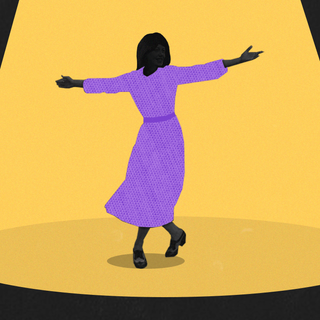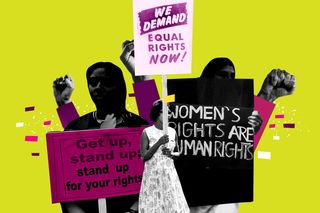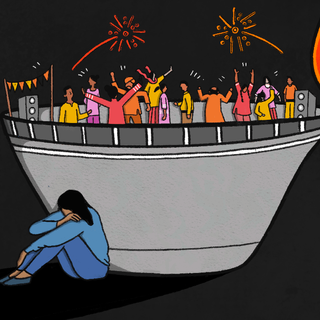
Whose Feminism Is It Anyway?
An exclusive excerpt from Sindhu Rajasekaran’s latest book “Smashing the Patriarchy.”

This is an exclusive excerpt from Sindhu Rajasekaran’s latest book“Smashing the Patriarchy” published by Aleph Book Company.
This is a time and space where women discursively produce conflicting meanings through their mix-and-match ideologies. They make bamboozling choices, as discussed earlier. To get on with their real-world objectives, women these days collude with patriarchies when it suits their interests and resist it when need be. A horde of educated women choose not to work outside the home and become hyper-domestic goddesses who utilize their husband/father/brother’s capital to live their best lives with no guilt attached. Those who work outside the home (on their laptops at cafés or at offices) happily socialize with peers of their economic class, language, race, religion, and caste, often employing their family/friends’ networks to find opportunities. The woke among them admit to these privileges, but retain them nevertheless. Capitalist and socialist ideologies intermingle unexpectedly in many women’s heads, as do tradition and modernity. They may take a liberal position on one issue, but turn conservative on another. Some are nationalistic, some aren’t. They take what they like from the jargon of feminism (when it serves to increase their sense of self-worth) and discard what doesn’t work for them. Postfeminist women, then, are self-defining, maximizing, and ambitious subjects who practice pragmatic idealism apt for such morally jaded times.
The ideological purists among us will say that now is the time to be dogmatic. The idea of India is in doldrums. Liberal democracy is being leached away at the edges. Hindutva is eclipsing the nation’s secular ethos. Islamophobia and casteist bigotry are on the rise. Dissent is being squashed with an iron fist. Feminism, as ever, should be [an]…ideology that unites women against the ills of patriarchy, capitalism, neoliberalism, caste, globalization, eco-fascism, religious fundamentalism, and all sorts of hegemony to create a truly equitable world. Except, woman is not a monolithic entity, especially in ‘new India’ where opinions are super polarized, and identity politics and ideological warfare are rife. There are powerful women on the left, right, and center. There is no compulsion here that all women should fight for the same sort of social or political revolution—because identities are plural and each woman espouses causes that are critical to her positionality. At the same time, feminism isn’t impervious to…prejudice either. In such a scenario, it’s unrealistic to expect women to gather under a rigid feminist umbrella that is theoretically for all women, but in reality, excludes many based on where their political loyalties lie or how they perform femininity.
Am I then suggesting that feminists stop questioning the motives of incendiary women for the sake of solidarity? Understandably, how on earth can feminists not be at odds with those like Bharatiya Janta Party’s (BJP) women wing’s leader Sunita Singh Gaur, who asked Hindu men to form gangs and rape Muslim women? Clearly, Gaur is not simply a victim of regressive thinking. If anything, she’s a self-empowered woman. Except, her words were held against her—she faced intense criticism, not only from the left and center, but also from the right. Even while men who actually let Muslim women get raped under their watch sit comfortably in their regal seats sipping chai, Gaur was dismissed. Patriarchy works in convoluted ways.
Academics and activists have always termed the women’s movement of the subcontinent as Indian feminisms, stressing on the plural, as not all women’s movements identified with Western-inspired feminism. Islamic women’s groups have been at odds with secular feminists, because the latter often refuse to recognize the former’s agency even while lobbying on their behalf. As evident from the Shaheen Bagh protests, Muslim women have always been capable of standing up for themselves when they see fit. The idea that every veiled woman is oppressed is preposterous but that is the notion most Bharatiya Muslim Mahila Andolan (BMMA) and All India Muslim Women Personal Law Board (AIMWPLB) counter Muslim orthodoxy and seek to reinterpret the Quran in more gender-egalitarian terms, because they believe that the Quran is essentially gender-equal. Meanwhile, secular feminist groups have been hell-bent on issues like abolishing the triple talaq (which the government has brought about) and bringing in the Uniform Civil Code (UCC) — which both BMMA and AIMWPLB are wary of. A large section of Hindu women, on the other hand, do not subscribe to the language of feminism because it positions itself as anti-Hindu (and since the Hindu Rashtra project began, a chasm has opened up between the Hindu nationalist and the secular woman). Women from other religions too are wary of feminism for it is often conflated with atheism.
Inside the fortress of feminism, meanwhile, not all versions have proximity to power. Undercurrents of dissent have always existed. Varied groups vie to construct competing ideological frameworks for gender-development discourses inside the academia. Resident Indian feminists are distrustful of expatriate feminists. Marxist feminists are suspicious of liberal feminists. Members of the LGBTQIA+ community have been vocal about cis-het feminism’s unease with trans identities (ever heard of TERF, the acronym for Trans-Exclusionary Radical Feminist?) Skepticism is everywhere. And since 2017, the fault lines of Indian feminism have become glaringly visible. It was then that law student Raya Sarkar circulated a Google spreadsheet that named seventy-two men from academia for various forms of sexual harassment. The Kafila feminists (called so because they signed a statement published on the Kafila website, asking for the withdrawal of said spreadsheet), including a number of seasoned academics and activists known for being anti-establishment, argued that naming and shaming men without due process was not acceptable. Young women disagreed.
Anthropologist Rama Srinivasan called this a generational conflict between feminist pioneers and millennials without patience. But this isn’t the only perceived fault line. Raya Sarkar also happens to be a Dalit, and the invalidation of her list by Savarna feminists was seen by Dalit, Bahujan, and Adivasi (DBA) women as a striking instance of caste bias. This sentiment has echoed across the country among young DBA women in various movements. Many DBA feminists left the women’s collective Pinjra Tod, writing, ‘Savarna feminists…we are no longer going to be fascinated by your sisterhood circles and tokenism inclusivity. Your Time is Up too.’
And just like that, the idea of feminist sorority crumbled in the public eye, yet again.
So, in such a time, when everyone’s walking on ideological eggshells, it may seem that it’s best to choose the safest feminist identity: the one of intersectional feminist. Every woke woman’s new favorite word, sorry to say, is already passé in the West where it came from (all hail Westeros). Sure, it sounds like the right thing to be, but what does it do for us in reality? Having empathy for another person’s struggle is all very well, but can it be put to practical use over and above showing solidarity, especially when the concerned person doesn’t care for (y)our savior complex? On the other hand, when (y)our identities are ones that were historically denied social justice, do we find solidarity with other women by radically denying them the right to speak about us altogether, thereby denying ourselves the right to speak about others?
Sindhu Rajasekaran is the author of a novel, Kaleidoscopic Reflections, which was nominated for the Crossword Book Award, and a collection of short stories, So I Let It Be. Her essays, poetry, and fiction have appeared in international publications and anthologies. She has a master’s in creative writing from the University of Edinburgh. Currently, she's a PhD researcher at the University of Strathclyde.
Related


How Some People Pretend To Be Unskilled at Certain Tasks To Avoid Doing Them
